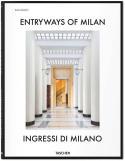Entryways of Milan
Karl Kolbitz
As the authors remind us, Milano has been labelled since the 16th century as the ugly duckling –regarding cities. How can this be the case for a city that is one of the world capitals of design? This apparent paradox encouraged author Karl Kolbitz, a native Berliner, to show that the actual beauty of Milano is hidden, more in tune with its introvert personality if compared to Rome or Florence. One just needs to peek into certain private homes built after the big boom of the beginning of the 20th century, between 1880 and 1910, when the population doubled in an atmosphere of economic euphoria, to gauge the care given to the decoration of hallways, staircases, and elevator shafts. From Ca’ Brütta by Giovanni Muzio (1919-23) to Casa del Cedro by Giulio Minoletti (1951-52), marble, crystal and bronze were common building material. The photographs are sober, taken from the front, and of course respect the parallel character of the vertical lines. But the main interest of the book lies in the deciphering of all the decorative elements. Carrara marble or peach flower marble? Bianco Montorfano granite, or the red version from Baveno? Macchavecchia limestone breccia, Tivoli travertine or Trani limestone? All these precious details allow the viewer to nurture the feeling of beauty. Here we see an interphone which is a sculpture by Adolfo Wildt, over there chandeliers by Vico Magistretti or ceramic tiles by Giò Ponti, and further on a handrail designed by Ceramica San Paolo from Venice. Who said Milano is ugly?
|  |
Review published in the newsletter #472 - from 11 May 2017 to 17 May 2017
